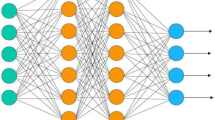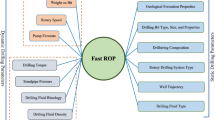Abstract
Cost and efficiency estimation for rotary drilling rigs is an essential step in the design of excavation projects. Due to the complexity of influencing factors on rotary drilling, sophisticated modeling methods are required for performance prediction. In this study, rate of penetration (ROP) of a rotary drilling machine using two developed modeling techniques, namely, non-linear multiple regression models (NLMR) and multilayer perceptron–artificial neural networks (MLP-ANN) were assessed. For this purpose, field and experimental data of various case studies were used. Several performance indexes, including determination coefficient (R2), variance accounted for (VAF), and root mean square error (RMSE), were evaluated to check the prediction capacity of the developed models. Considering multiple inputs in various NLMR models, the most influencing factors on ROP were determined to be brittleness, rock quality designation (RQD) index, water content, and anisotropy index. Multivariate analysis results of developed models showed that the MLP–ANN model indicates higher precision in performance prediction than the NLMR model for both the training and testing datasets. Additionally, sensitivity analysis showed that RQD and water content have significant influence on the ROP. The models proposed in this study can successfully be applied to predict the ROP in rocks with similar characteristics.









Similar content being viewed by others
References
Akin S, Karpuz C (2008) Estimating drilling parameters for diamond bit drilling operations using artificial neural networks. Int J Geomech 8:68–73
Akun ME, Karpuz C (2005) Drillability studies of surface-set diamond drilling in Zonguldak region sandstones from Turkey. Int J Rock Mech Min Sci 42:473–479
Altindag R (2010) Assessment of some brittleness indexes in rock-drilling efficiency. Rock Mech Rock Eng 43:361–370
Altindag R (2004) Evaluation of drill cuttings in prediction of penetration rate by using coarseness index and mean particle size in percussive drilling. Geotech Geol Eng 22:417–425
Alvarez Grima M, Babuska R (1999) Fuzzy model for the prediction of unconfined compressive strength of rock samples. Int J Rock Mech Min Sci 36:339–349
Ataei M, Kakaie R, Ghavidel M, Saeidi O (2015) Drilling rate prediction of an open pit mine using the rock mass drillability index. Int J Rock Mech Min Sci 73:130–138
ASTM (2005) Standard test method for determination of rock hardness by rebound hammer method. ASTM Standards: D5873–05, West Conshohocken, PA
ASTM (2007) Standard test method for compressive strength and elastic moduli of intact rock core specimens under varying states of stress and temperatures. ASTM Standards: D7012–07, West Conshohocken, PA
ASTM (2008) Standard test method for determination of the point load strength index of rock and application to rock strength classifications. ASTM Standards: D5731–08, West Conshohocken, PA
Basheer IA (2000) Selection of methodology for neural network modelling of constitutive hysteresis bahavior of soils. Comput Aided Civ Inf Eng 15:440–458
Basheer IA, Hajmeer M (2000) Aritificial neural networks: fundamentals, computing, design and application. J Microbiol Methods 43:3–31
Bhatnagar A, Khandelwal M (2012) An intelligent approach to evaluate drilling performance. Neural Comput Applic 21:763–770
Bruland A (1998) Hard rock tunnel boring. PhD thesis, Norwegian University of Science and Technology, Trondheim
Bruland A, Dahlo TS, Nilsen B (1995) Tunnelling performance estimation based on drillability testing. In: Proc 8th Int Congress in Rock Mechanics. Tokyo, pp 123–126
Capik M, Yilmaz AO, Yasar S (2017) Relationships between the drilling rate index and physicomechanical rock properties. Bull Eng Geol Environ 76:253–261
Chen X, Fan H, Guo B, Gao D, Wei H, Ye Z (2014) Real-time prediction and optimization of drilling performance based on a new mechanical specific energy model. Arab J Sci Eng 39:8221–8231
Cheniany A, Khoshrou Seyed H, Shahriar K, Khademi Hamidi J (2012) An estimation of the penetration rate of rotary drills using the specific rock mass Drillability index. Int J Min Sci Technol 22:187–193
Brown ET (1981) Rock characterization, testing and monitoring: ISRM suggested methods. Pergamon Press, Oxford
Dahl F, Bruland A, Jakobsen PD, Nilsen B, Grøv E (2012) Classifications of properties influencing the drillability of rocks, based on the NTNU/SINTEF test method. Tunn Undergr Space Technol 28:150–158
Dursan AE, Gokay MK (2015) Cuttability assessment of selected rocks through different brittleness values. Rock Mech Rock Eng 49:1173–1190
Gokceoglu C (2002) A fuzzy triangular chart to predict the uniaxial compressive strength of the Ankara agglomerates from their petrographic composition. Eng Geol 66:39–51
Gokceoglu C, Zorlu K (2004) A fuzzy model to predict the uniaxial compressive strength and modulus of elasticity of a problematic rock. Eng Appl Artif Intell 17:61–72
Hecht-Nielsen R (1987) Kolmogorov’s mapping neural network existence theorem. In: Proc First IEEE Int Conf on Neural Networks. San Diego, pp 11–14
Hoseinie SH, Aghababaei H, Pourrahimian Y (2008) Development of a new classification system for assessing of rock mass drillability index (RDi). Int J Rock Mech Min Sci 45:1–10
Hoseinie SH, Ataei M, Osanloo M (2009) A new classification system for evaluating rock penetrability. Int J Rock Mech Min Sci 46:1329–1340
Howarth DF, Adamson WR, Berndt JR (1986) Correlation of model tunnel boring and drilling machine performances with rock properties. Int J Rock Mech Min Sci 23:171–175
IBM Corp. (2007) SPSS Statistics version 24. SPSS regression models. IBM Corp., Armonk
Kahraman S (1999) Rotary and percussive drilling prediction using regression analysis. Int J Rock Mech Min Sci 36:981–989
Kahraman S (2016) Estimating the penetration rate in diamond drilling in laboratory works using the regression and artificial neural network analysis. Neural Process Lett 43:523–535
Kahraman S, Balci C, Yazici S, Bilgin N (2000) Prediction of the penetration rate of rotary blast hole drilling using a new drillability index. Int J Rock Mech Min Sci 37:729–743
Kahraman S, Bilgin N, Feridunoglu C (2003) Dominant rock properties affecting the penetration rate of percussive drills. Int J Rock Mech Min Sci 40:711–723
Kahraman S, Altun H, Tezekici BS, Fener M (2006) Sawability prediction of carbonate rocks from shear strength parameters using artificial neural networks. Int J Rock Mech Min Sci 43:157–164
Khademi Hamidi J, Shahriar K, Rezai B, Rostami J (2010) Performance prediction of hard rock TBM using rock mass rating (RMR) system. Tunn Undergr Space Technol 25:333–345
Khandelwal M, Faradonbeh RS, Monjezi M, Armaghani DJ, Abd Majid MZB, Yagiz S (2017) Function development for appraising brittleness of intact rocks using genetic programming and non-linear multiple regression models. Eng Comput 33:13–21
Looney CG (1996) Advances in feed-forward neural networks: demystifying knowledge acquiring black boxes. IEEE Trans Knowl Data Eng 8(2):211–226
M’Gonigle JW, Dover JH (1992) Geologic map of the Kemmerer 30 × 60 quadrangle, Lincoln, Uinta, and Sweetwater counties, Wyoming. U.S. Geological Survery Miscellaneous Investigations Series Map I-2079. Wyoming State Geological Survey, Laramie
Manouchehrian A, Sharifzadeh M, Hamidzadeh Moghadam R (2012) Application of artificial neural networks and multivariate statistics to estimate UCS using textural characteristics. Int J Min Sci Technol 22:229–236
Mansouri M, Moomivand H (2010) Influence of rock mass properties on TBM penetration rate in Karaj-Tehran water conveyance tunnel. J Geol Min Res 2:114–121
Mohammadi SD, Torabi-Kaveh M, Bayati M (2015) Prediction of TBM penetration rate using intact and mass rock properties (case study: Zagros long tunnel, Iran). Arab J Geosci 8:3893–3904
Munoz H, Taheri A, Chanda EK (2016) Rock drilling performance evaluation by an energy dissipation based rock brittleness index. Rock Mech Rock Eng 49:3343–3355
Nelson M, Illingworth WT (1990) A practical guide to neural nets. Addison-Wesley, Reading
Rabia H (1982) Specific energy as a criterion for drill performance prediction. Int J Rock Mech Min Sci Geomech Abstr 19:39–42
Saeidi O, Torabi SR, Ataei M (2013) Development of a new index to assess the rock mass drillability. Geotech Geol Eng 31:1477–1495
Shirani Faradonbeh R, Monjezi M, Armaghani DJ (2016) Genetic programing and non-linear multiple regression techniques to predict backbreak in blasting operation. Eng Comput 32:123–133
Singh TN, Gupta AR, Sain R (2006) A comparative analysis of cognitive system for the prediction of drillability of rocks and wear factor. Geotech Geol Eng 24:299–312
Sonmez H, Gokceoglu C, Nefeslioglu HA, Kayabasi A (2006) Estimation of rock modulus: for intact rock with an artificial neural network and for rock masses with a new empirical equation. Int J Rock Mech Min Sci 43:224–235
Su O (2016) Performance evaluation of button bits in coal measure rocks by using multiple regression analyses. Rock Mech Rock Eng 49:541–553
Swingler K (1996) Applying neural networks: a practical guide. Academic Press, New York
The MathWorks Inc. (2016) MATLAB version 9.0.0.341360. The MathWorks Inc., Natick
Thuro K (1997) Drillability prediction: geological influences in hard rock drill and blast tunneling. Geol Rundsch 86:426–438
Timpson TC (2011) Characterization of strength and deformation properties of rock material for design of drilled shafts under lateral load. MSc Thesis. The University of Utah, Salt Lake City
United States Geological Survey (USGS) (2010) http://seamless.usgs.gov/
Wyoming State Geological Survey (WSGS) (2010) www.wsgs.uwyo.edu/GIS/DigitalData/
Yagiz S (2008) Utilizing rock mass properties for predicting TBM performance in hard rock condition. Tunn Undergr Space Technol 23:326–339
Yagiz S, Gokceoglu C (2010) Application of fuzzy inference system and nonlinear regression models for predicting rock brittleness. Expert Syst Appl 37:2265–2272
Yagiz S, Gokceoglu C, Sezer E, Iplikci S (2009) Application of two non-linear prediction tools to the estimation of tunnel boring machine performance. Eng Appl Artif Intell 22:808–814
Yarali O, Kahraman S (2011) The drillability assessment of rocks using the different brittleness values. Tunn Undergr Space Technol 26:406–414
Yarali O, Soyer E (2013) Assessment of relationships between drilling rate index and mechanical properties of rocks. Tunn Undergr Space Technol 33:46–53
Yasar S, Capik M, Yilmaz AO (2015) Cuttability assessment using the drilling rate index (DRI). Bull Eng Geol Environ 74:1349
Acknowledgements
The authors would like to thank the staff of Western Australian School of Mines (WASM), Curtin University, Australia for their kind help during the research period.
Author information
Authors and Affiliations
Corresponding author
Rights and permissions
About this article
Cite this article
Darbor, M., Faramarzi, L. & Sharifzadeh, M. Performance assessment of rotary drilling using non-linear multiple regression analysis and multilayer perceptron neural network. Bull Eng Geol Environ 78, 1501–1513 (2019). https://doi.org/10.1007/s10064-017-1192-3
Received:
Accepted:
Published:
Issue Date:
DOI: https://doi.org/10.1007/s10064-017-1192-3




